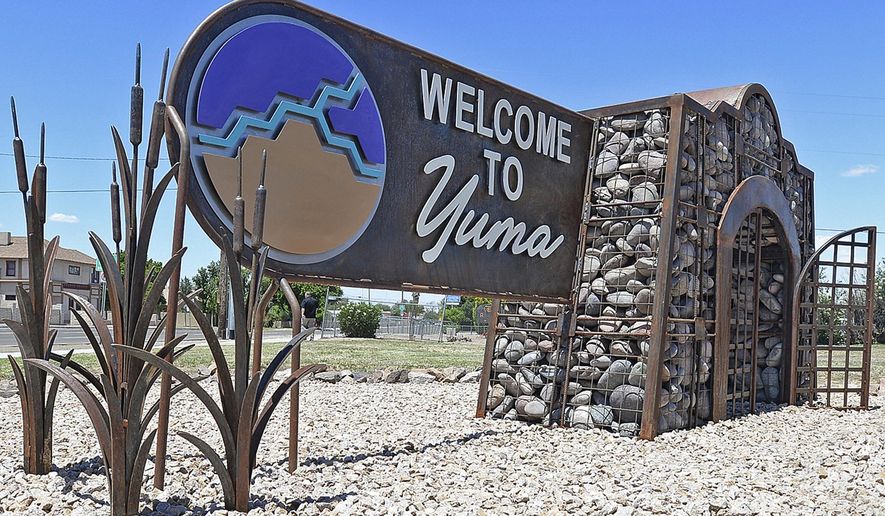It’s not just Haitians, and it’s not just Texas where the border seems out of control.
Some 3,400 migrants — most of them Brazilian, Venezuelan or Cuban — were mired in Border Patrol holding facilities in Yuma, Arizona, over the weekend, according to the sheriff, who said he has never seen such unruliness.
Video shows long streams of migrants walking around the border wall and surrendering to authorities. Most of them figure they will be caught and released, and many of them are right.
“It’s getting a lot worse,” said Yuma County Sheriff Leon Wilmot. “I’ve never seen it this bad with Border Patrol having to hold so many, and dealing with the issues we’re dealing with now because the administration won’t enforce the law.”
Agents have been pulled off the line to shift to caretaking duties. Sheriff Wilmot said he can drive a 20-mile stretch of the border and see only a handful of agents because “everybody else is busy processing” the thousands of migrants in custody.
That leaves the border open to migrants who want to slip through unnoticed and to smugglers carrying a surging amount of drugs such as fentanyl, the sheriff said.
On Sept. 22 alone, the Border Patrol in Yuma apprehended 1,000 people. The number on a typical day is 600 to 700. A year ago, at the end of the Trump era, it was 25 to 35 a day, the sheriff said.
Yuma is about 1 thousand miles west of Del Rio, Texas, where an unprecedented migrant camp sprang up this month on the U.S. bank of the Rio Grande. Thousands of Haitians crossed the river at will. After breaching the border, they waited to be caught and released to establish a foothold on American soil.
Homeland Security Secretary Alejandro Mayorkas declared victory this weekend in Del Rio after the camp was emptied of migrants. He acknowledged that officials released about 13,000 of the more than 15,000 people at the camp at its peak with the hope that they would show up for eventual immigration court dates.
Yuma is different from Del Rio.
The 3,400 migrants were in custody, and Border Patrol said it was processing and turning them over to U.S. Immigration and Customs Enforcement. ICE is deciding whom to release.
Of those 3,400, about 2,000 are single adults. If they were from the traditional sending countries of Mexico or the Northern Triangle area of Central America — Guatemala, Honduras and El Salvador — they could be quickly expelled.
But they come from much farther afield, and the Biden administration says it’s not getting as much cooperation from Mexico in taking them back as the Trump team did.
Sheriff Wilmot said Yuma was holding about 930 people from Brazil, 819 from Venezuela, 430 Cubans, 400 Haitians, 270 Colombians and others from a mix of countries.
CBP said it can handle the task.
“Responding to changing migration patterns is not new to CBP and the Border Patrol, and Yuma Sector continues to redirect manpower as traffic patterns change,” the agency told The Washington Times.
CBP said a new tent facility allows for more capacity and insists it expels those it can under a pandemic border policy.
Sheriff Wilmot said those are few.
Of 110,000 crossers caught in the Yuma Sector this fiscal year, only about 10,000 have been expelled, he said.
In 2020, a total of 8,000 were apprehended in Yuma. It is the hardest-hit of the nine Border Patrol sectors along the U.S.-Mexico boundary.
Mr. Mayorkas told Congress last week that the numbers were dropping from unprecedented levels in July and August.
“I have been quite clear that we do have a plan to address migration at the southern border. We’re executing it. It takes time, and we’re starting to see the results,” the secretary said.
Sheriff Wilmot said he hasn’t seen much evidence of Mr. Mayorkas’ effort.
“The thing that aggravates the sheriffs as a whole is the administration doesn’t have a plan. They said they have one, but they’re not willing to share it. And it hasn’t worked if they did have one,” he said.
The fiscal year ends Thursday, and 2021 is flirting with the record for Border Patrol apprehensions, set in the 1980s. If September is as bad as July and August, it will set a record, but if Mr. Mayorkas is right, the number will fall just shy.
Some signs show that pressure is easing. The number of unaccompanied juvenile migrants, often a leading indicator of the overall flow, has dropped significantly, from catastrophic to merely troubling.
Yet experts say 2021 is already the worst year on record qualitatively, given how many have been caught and released into the country and the striking number from beyond traditional sending nations.
In August, the latest month with full numbers, nearly 60,000 — more than 30% — of the migrants nabbed by Border Patrol agents along the Mexico boundary were from outside the traditional sending nations. In December, the last full month of the Trump era, the number was fewer than 8,000, or about 10% of the total.
• Stephen Dinan can be reached at sdinan@washingtontimes.com.




Please read our comment policy before commenting.